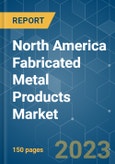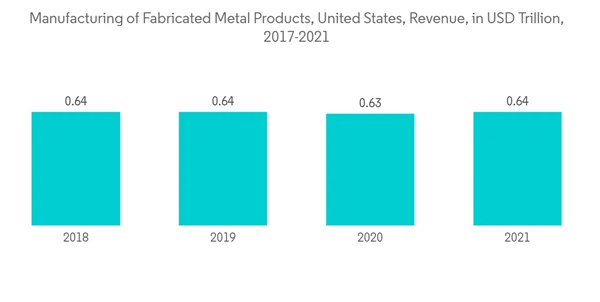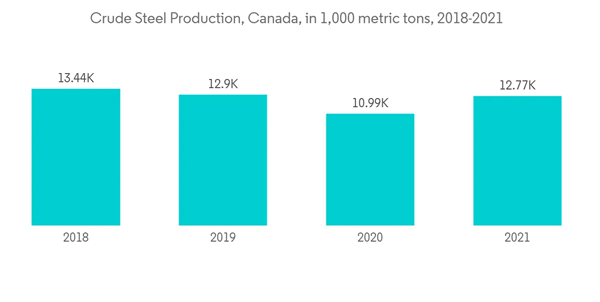Key Highlights
- Within the market for metal fabrication in North America, perforated metal has advanced. The use of perforation rollers to punch metal evenly and uniformly is becoming more widespread in the metal manufacturing sector. To satisfy clients' requirements, equipment manufacturers are working to provide rollers that are project-specific. A rising market exists for perforation rollers that can punch cleanly through metal repeatedly while operating either cold or heated because the heated pin in these rollers forms a strengthened ring around the perforation to boost the metal's strength, and they are offering new prospects for metal fabricating businesses. On the other hand, lasers are receiving a lot of attention for their use in metal piercing.
- In June 2022, manufacturing sales in Windsor dropped 22.9% to USD 1.2 billion. This was mostly because fewer cars and car parts were sold.Since 2021, there has been a shortage of microchips around the world, which has caused the auto industry in Windsor to shut down more than once.Higher sales in the machinery and fabricated metal industries offset some of the declines. Following a 1.1% drop in May 2022, manufacturing sales fell 0.8% to USD 71.8 billion in June 2022, due to lower sales in 8 of 21 industries, led by petroleum and coal products (-7.8%), wood products (-7.2%), and aerospace products and parts (-16.8%). Meanwhile, motor vehicle sales (+13.8%) and chemical product sales (6.0%) increased the most.
- Automotive has been the most turbulent of the industries that fabricators serve. The sector experienced significant declines in the first and second quarters of 2021 before regaining momentum late in the year. According to ASIS, momentum continued to build in the first and second quarters of 2022 before slowing again later in the year. Overall, the industry will be better off, but it will be a bumpy ride. The global shortage of microchips is to blame for the majority of the volatility.
- Almost all of those sectors experienced significant volatility in 2020 and 2021. Due to obvious reasons, business declined in early 2020, but as the global supply chain became more efficient, it continued to rebound. Parts of the metal fabrication industry are thriving. The sector is still pulling, eager to take off. Because of recently passed legislation in Washington, that pull is likely to become stronger with additional infrastructure spending. The global supply chain simply needs to catch up, and inflationary pressures will persist until it does. Given all of this, 2022-2023 is shaping up to be a year full of opportunity, despite its volatility.
North America Fabricated Metal Products Market Trends
Growing Demand for Advanced Automotive and Industrial Parts
One of the main reasons for the growth of the international auto parts market is that people are using technology more and more.Auto parts are fabricated and manufactured using 3D printing technology. Furthermore, most vehicles produced today incorporate a diverse range of additively manufactured and fabricated parts into the assembly. This includes everything from engine components, gears, gearboxes, and brake components to frame construction. Motor vehicle and parts manufacturing in the United States generated a gross output of approximately USD 721 billion in 2021. Between 2018 and 2020, global automotive industry growth slowed; sales of new light vehicles fell, and motor vehicle production output did not recover from the pandemic, reaching 80 million in 2021.Automotive and aviation are two industries that use a lot of industrial fasteners. This is because both the process of making the product and the product itself have a lot of parts. Fasteners such as nuts, bolts, screws, and washers are commonly used in these industries. As the region's demand for commercial and passenger vehicles grows, so does the demand for automotive-grade industrial fasteners. In April 2022, passenger car sales in 2021 totaled 345.35 thousand units, with light truck sales totaling 1,293.7 thousand units, up from 325.49 thousand units in 2020 and 1233.06 thousand units in 2021.
North America became a major market for making aircraft parts around the world in 2021. This is because the area has a lot of companies that make parts for planes and a well-established industry for making planes. Rising passenger traffic is expected to drive growth. Furthermore, technological progress is expected to provide significant growth opportunities. To improve safety, quality, and efficiency, aircraft manufacturers are employing ML (machine learning) and AI (artificial intelligence) approaches. Machine learning algorithms collect and analyze data to reach more accurate conclusions. These technological advancements help reduce production costs while also improving aircraft performance.
Increased Production of Steel creating Demand for Fabricated Products
After a very high rate of growth in 2021, the US metals and steel industry is expected to grow by about 5% this year. This is mostly due to the strong demand from the residential construction, aerospace, transportation, and engineering industries, which have all been strong in recent years.But since fuel prices are high and consumer prices are going up, the drop in car sales in the first half of 2022 shows less demand for expensive, metal-intensive consumer goods.Order backlogs persist in the face of supply chain constraints. While oil and gas prices have skyrocketed, strong demand allows metals and steel companies to pass on higher input costs. The industry benefits from the fact that some US manufacturers have returned to their home countries to avoid further supply chain disruptions and improve price stability.Due to the partial reduction of Section 232, tariffs on EU imports, and the weaker EUR relative to the USD, the US metals and steel industry is facing increased competition from EU peers in its domestic market. This has limited domestic production's growth in 2022, when it is expected to increase by about 3%. Persistently high inflation remains a downside risk, as it could prompt the Federal Reserve to tighten monetary policy more aggressively. A hard economic landing would reduce consumption and investment, dampening demand for metals and steel.
North America Fabricated Metal Products Industry Overview
The fabricated metal products market in North America is fragmented, with the presence of a large number of local and regional players as well as a few global players. The major players include Valmont Industries, Inc., Mayville Engineering Company, Inc., PMF Industries, Inc., Monti Inc. Manufacturing, Prince Manufacturing, Inc., and many others. The players in the market are driven by huge demand from the industrial and defense-allied sectors. The market has a presence of high-end technologies; thus, the products and services available are the main factors differentiating the players entering the market.Additional Benefits:
- The market estimate (ME) sheet in Excel format
- 3 months of analyst support
This product will be delivered within 2 business days.
Table of Contents
Companies Mentioned (Partial List)
A selection of companies mentioned in this report includes, but is not limited to:
- Valmont Industries, Inc.
- Mayville Engineering Company, Inc.
- PMF Industries, Inc
- Monti Inc. Manufacturing
- Prince Manufacturing, Inc.
- O' Neal Manufacturing Services
- BTD Manufacturing Inc.
- United Steel, Inc.
- Colfax
- Komaspec
- Matcor Matsu Group Inc.
- Sandvik Mining and Construction Canada Inc.*










